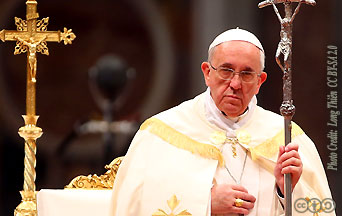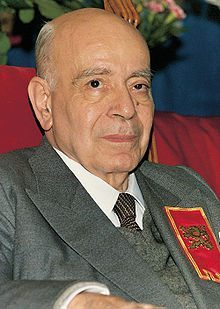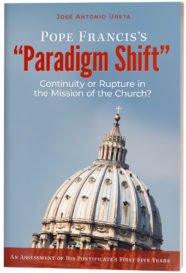Resisting the Grave Errors in Pope Francis’s Apostolic Exhortation Querida Amazonia
The Errors in the Synod’s Prior Documents Were Not Condemned
Querida Amazonia neither corrected nor condemned the grave errors in the Synod’s previous documents, both the Instrumentum Laboris,1 and the Final Document, titled The Amazon: New Paths for the Church and for an Integral Ecology.2 Instead, the Apostolic Exhortation retained those documents’ inspiration, namely the pantheistic evolutionism of the modernist heresy and Fr. Teilhard de Chardin, S.J.Consequently, the serious criticism from cardinals and bishops that the Instrumentum Laboris contains heresies and is implicitly pantheistic remains valid.3
Querida Amazonia Quotes Poets, but not Fathers of the Church
Querida Amazonia does not quote Church Fathers and Doctors,4 as would be expected in a pontifical document. Instead, it highlights communist writers and poets. This makes the papal document almost surreal.5On the other hand, Querida Amazonia attributes to the Amazonian indigenous peoples beliefs and customs that do not exist there. They belong to natives from other regions. Such is the case, for example, with the Pachamama “goddess”—which became the symbol of the Amazon Synod. Pachamama is not worshiped by the Amazonian indigenous people, but by those of the Andes mountain system.6
A Fictional Amazon
Like the Synod of Bishops for the Pan-Amazon region itself, Pope Francis’s Post-Synodal Apostolic Exhortation Querida Amazonia does not discuss the Amazon region as it is. Rather, the exhortation dreams of a Utopia, “an imaginary place or state in which everything is perfect,”7 calling it Amazonia.The Amazon Synod and the Vatican’s Radical Environmentalism
Like the “noble savage” (or good savage) dreamed up by eighteenth century Enlightenment philosophy, the denizens of Querida Amazonia are also fictional: Perfect, pure, and wise indigenous living in direct contact with a pristine Nature, a world where both jungle and tribesmen are as yet “uncorrupted” by progress and civilization.Since the “noble savage” myth pervades all of the Pan-Amazon Synod’s documents, the Synod itself, and is one of the keys to understanding Querida Amazonia, it is worthwhile to explore it a bit more.
Querida Amazonia and Rousseau’s “Noble Savage”
Writing in 2004 on the myth of the good savage, Canadian professor Jany Boulanger offers interesting insights on the topic:“Free, sensual, polygamous, communist, and good: these are the common features, highly caricatured, of the inhabitants of this ‘best of all worlds.’ … Without a doubt, Jean-Jacques Rousseau (1712–1778) is recognized as the one who most shared this myth by defending this idea, which runs through most of his work: ‘Nature has made man happy and good, but society makes him depraved and miserable.’”For Rousseau, civilization and private property are evil. Prof. Boulanger continues:
“In his philosophical essays, Discours sur les sciences et les arts (1750), and Discours sur l’origine et les fondements de l’inégalité parmi les hommes (1755), Rousseau claims that man’s primitive state leads him toward virtue and happiness because his very ignorance of evil prevents it from spreading. The development of his intellect and his search for luxury, property, and power, encouraged by social institutions, are what cast man out of a paradise possibly closer to Nature.”8
Querida Amazonia and Aboriginal “Wisdom”
And so it is for Querida Amazonia as well. For Pope Francis, the Amazon’s so-called original peoples have not been “corrupted” by social institutions. They have preserved an “ancestral wisdom,” which they should transmit to the civilized world. Moreover, their “wisdom” must inform “Gospel inculturation” in the Amazon region.A grouping of phrases from the exhortation Querida Amazonia illustrates the decisive role it ascribes to the natives’ so-called ancestral wisdom:
“The wisdom of the way of life of the original peoples” (no. 22).
Integration into urban life “disrupts the cultural transmission of a wisdom that had been passed down for centuries from generation to generation” (no. 30).
“Even now, we see in the Amazon region thousands of indigenous communities…. Each distinct group … in a vital synthesis with its surroundings, develops its own form of wisdom” (no. 32).
“For centuries, the Amazonian peoples passed down their cultural wisdom orally, with myths, legends, and tales” (no. 34).
“The wisdom of the original peoples of the Amazon region ‘inspires care and respect for creation, with a clear consciousness of its limits, and prohibits its abuse’” (no. 42).
“To protect the Amazon region, it is good to combine ancestral wisdom with contemporary technical knowledge, always working for a sustainable management of the land while also preserving the lifestyle and value systems of those who live there” (no. 51).
“For the Church to achieve a renewed inculturation of the Gospel in the Amazon region, she needs to listen to its ancestral wisdom” (no. 70).
“[W]e are called ‘to be their friends, to listen to them, to speak for them and to embrace the mysterious wisdom which God wishes to share with us through them.’ [103] Those who live in cities need to appreciate this wisdom and to allow themselves to be ‘re-educated’” (no. 72).
Does Grace “Suppose Culture”?
The concept of indigenous “ancestral wisdom” is one of Querida Amazonia’s central points. Where would this so-called wisdom come from? What is its nature? The papal exhortation claims that it was supposedly transmitted “orally, with myths, legends, and tales.” However, the exhortation says nothing about its origin and nature. Is this “mysterious wisdom” of natural or supernatural origin? Is it the result of grace or primitive revelation? Since Pope Francis claims that this “ancestral wisdom” should “inculturate” the Church, then it would seem likely that he considers it to be of divine origin, immanent in man. That is also what the modernist heresy sustains.9The word “inculturation” is used twenty times in Querida Amazonia. It partners, as it were, in tandem, with the “ancestral wisdom” myth. But if the natives already possess wisdom and goodness (“the goodness that already exists in Amazonian cultures” – no. 66), then the role of the Church is not to convert them. Instead, the Church “brings it [the supposed goodness] to fulfillment in the light of the Gospel” (no. 66).
A Mission That Baptized No One in Fifty-Three Years:
The Flawed Evangelization Model of the Pan-Amazonian Synod
The
Apostolic Exhortation exaggerates the role of culture, using the term
forty-five times. It urges a dialogue with, an understanding of
“Amazonian sensibilities and cultures from within” (no. 86). But Pope
Francis goes far beyond this when he changes the classic theological
axiom that “grace presupposes nature”10 to affirm that “grace supposes culture” (no. 68).11Now, according to the classic definition, grace is “a supernatural gift of God to intellectual creatures (men, angels) for their eternal salvation, whether the latter be furthered and attained through salutary acts or a state of holiness.”12 Hence “[o]nly a rational or intellectual nature is susceptible to grace since it is by means of grace that the rational creature is lead to its ultimate perfection, which consists in the vision of God’s essence (visio beatifica).”13
In asserting that grace “supposes culture,” the human and angelic natures seem to be confused or identified with culture, which has a pantheistic flavor.
Inculturate the Church in “Ancestral Wisdom”
If grace supposes culture, then it follows that Querida Amazonia wants to inculturate the Gospel in the “ancestral wisdom” of the natives.Indeed, one reads in the exhortation:
For the Church to achieve a renewed inculturation of the Gospel in the Amazon region, she needs to listen to its ancestral wisdom, listen once more to the voice of its elders, recognize the values present in the way of life of the original communities, and recover the rich stories of its peoples. In the Amazon region, we have inherited great riches from the pre-Columbian cultures. These include “openness to the action of God, a sense of gratitude for the fruits of the earth, the sacred character of human life and esteem for the family, a sense of solidarity and shared responsibility in common work, the importance of worship, belief in a life beyond this earth, and many other values (no. 70).14
These Are the Destructive Goals of the Pan-Amazon Synod
This “ancestral wisdom” of the Amazonian aborigines with which Pope Francis wants to inculturate the Gospel included the practice of cannibalism and polygamy.15 Thirteen ethnic groups in the Amazon region still practice infanticide, with some support from Brazil’s Indigenous Missionary Council.16 It is impossible to reconcile these practices with the Gospel of Our Lord Jesus Christ.Ecclesiastical Tribalism and Pentecostalism
The dream presented in the Querida Amazonia of a Church “inculturated” in the tribal molds was foreseen by the great Catholic thinker Plinio Corrêa de Oliveira in 1976 in his essay Revolution and Counter-Revolution:
“Obviously,
it is not only the temporal realm that the Fourth Revolution wants to
reduce to tribalism. It wants to do the same with the spiritual realm.
How this is to be done can already be clearly seen in the currents of
theologians and canonists who intend to transform the noble, bone-like
rigidity of the ecclesiastical structure – as Our Lord Jesus Christ
instituted it and twenty centuries of religious life molded it – into a
cartilaginous, soft, and amorphous texture of dioceses and parishes
without territories and of religious groups in which the firm canonical
authority is gradually replaced by the ascendancy of Pentecostalist
“prophets,” the counterparts of the structuralist-tribalist witch
doctors. Eventually, these prophets will be indistinguishable from witch
doctors. The same goes for the progressivist-Pentecostalist parish or
diocese, which will take on the appearances of the cell-tribe of
structuralism.”17
Following in the Steps of Teilhard de Chardin
As part of this inculturation of the Church with indigenous “culture,” Querida Amazonia has parts that evoke the Church-condemned pantheistic evolutionism of Fr. Teilhard de Chardin, S.J., the so-called mystic of the “cosmic Christ.”18The Apostolic Exhortation states that “the indigenous peoples of the Amazon Region express the authentic quality of life as ‘good living.’ This involves … communal and cosmic harmony” (no. 71). Querida Amazonia then goes on to this pantheistic-flavored Teilhardian tirade:
Certainly, we should esteem the indigenous mysticism that sees the interconnection and interdependence of the whole of creation, the mysticism of gratuitousness that loves life as a gift, the mysticism of a sacred wonder before nature, and all its forms of life.Querida Amazonia continues, citing Pope Francis’s Teilhardian encyclical Laudato Si’, “Similarly, a relationship with Jesus Christ, true God and true man, liberator and redeemer, is not inimical to the markedly cosmic worldview that characterizes the indigenous peoples, since he is also the Risen Lord who permeates all things. …[T]he Son of God has incorporated in his person part of the material world, planting in it a seed of definitive transformation” (no. 74).
At the same time, though, we are called to turn this relationship with God present in the cosmos into an increasingly personal relationship with a “Thou” who sustains our lives and wants to give them a meaning, a “Thou” who knows us and loves us (no. 73).
The Anti-Pastoral Work of the Amazon Synod. What You Need to Know
Again citing Laudato Si’, the Apostolic Exhortation states:The inculturation of Christian spirituality in the cultures of the original peoples can benefit in a particular way from the sacraments since they unite the divine and the cosmic, grace, and creation. In the Amazon region, the sacraments should not be viewed in discontinuity with creation. They “are a privileged way in which nature is taken up by God to become a means of mediating supernatural life.” They are the fulfillment of creation, in which nature is elevated to become a locus and instrument of grace, enabling us “to embrace the world on a different plane (no. 81).Still citing Laudato Si’, the document suggests that matter is divinized and presents the Eucharist as a “fragment of matter”: “In the Eucharist, God, ‘in the culmination of the mystery of the Incarnation, chose to reach our intimate depths through a fragment of matter.’ The Eucharist ‘joins heaven and earth; it embraces and penetrates all creation’” (no. 82).
It is clear in these passages, perhaps more than in other places, how Pope Francis’s new document exploits the Amazon and its indigenous peoples, using them as a mere pretext to spread evolutionary cosmic pantheism.
Learn All About the Prophecies of Our Lady of Good Success About Our Times
Will “Pachamama” Worship Be Part of an Inculturated Liturgy?
The exhortation explains the liturgy’s inculturation: “‘[E]ncountering God does not mean fleeing from this world or turning our back on nature.’ It means that we can take up into the liturgy many elements proper to the experience of indigenous peoples in their contact with nature and respect native forms of expression in song, dance, rituals, gestures, and symbols. The Second Vatican Council called for this effort to inculturate the liturgy among indigenous peoples” (no. 82).A telling illustration of how to do this Amazonian inculturation in Church ceremonies was the worshipping of the Pachamama goddess (Mother Earth) done on October 4, 2019, in the Vatican Gardens, then in Saint Peter’s Basilica, and in a procession with two bishops carrying the idol on a kind of float from the Basilica to the hall in which the Synod Fathers gathered. Pope Francis was present on all these occasions and gave the Pachamama idol a blessing during the first one.19
Having Worshipped Pachamama, Pope Francis Now Disparages Mary’s Co-Redeeming Role
In Querida Amazonia, Pope Francis seeks to justify all these ceremonies worshipping the Pachamama goddess:20 “It is possible to take up an indigenous symbol in some way, without necessarily considering it as idolatry. A myth charged with spiritual meaning can be used to advantage and not always considered a pagan error” (no. 79).Querida Amazonia also reiterates the moral laxity of Amoris Laetitia: “[T]he Church must be particularly concerned to offer understanding, comfort, and acceptance, rather than imposing straightaway a set of rules that only lead people to feel judged and abandoned by the very Mother called to show them God’s mercy” (no. 84).
Not a Victory for Conservatives
Since Querida Amazonia does not mention the ordaining of married men (viri probati) as priests or women as deaconesses, some conservatives claimed victory. It is true that many liberal Catholics were looking forward to this step, and the Final Document called for it. Thus, in a sense, one can say that the omission was a conservative victory. However, as we will see below, it was not a true victory, but a pyrrhic one.21 Pope Francis transcended the issue, addressing it on a much higher plane and in a devastating manner. The sad truth is that Querida Amazonia points to a change in the priestly ministry and liturgy that achieves the same results in practice, without appearing to do so. This subversive change is in line with the new Church’s understanding of grace and the sacraments.Querida Amazonia points out the way ahead for progressives in the form of a rhetorical question: “Inculturation should also be increasingly reflected in an incarnate form of ecclesial organization and ministry. If we are to inculturate spirituality, holiness, and the Gospel itself, how can we not consider an inculturation of the ways we structure and carry out ecclesial ministries?” (no. 85).
Listen to the Amazon Indians Not Liberation Theologians!
True, the document states that only an ordained priest can consecrate and “preside at the Eucharist” (see nos. 86–90). However, it also says that Amazonian inculturation “requires the stable presence of mature and lay leaders endowed with authority … requires the Church to be open to the Spirit’s boldness, to trust in, and concretely to permit, the growth of a specific ecclesial culture that is distinctively lay” (no. 94).These “mature and lay leaders” sound very much like the Synod’s “viri probati.” Since the type of authority these male or female mature and lay leaders will receive is not made clear, bishops or episcopal conferences may interpret it as they see fit. This is how the bishops of Malta and Argentina interpreted Amoris Laetitia regarding the admission of divorced and “remarried” Catholics to Holy Communion.22 And, just as those bishops received the pope’s approval and that approval was proclaimed Church magisterium and incorporated into the Acta Apostolicae Sedes, so also now, one can reasonably foresee that Pope Francis will similarly approve these new “Church with an Amazonian face” inculturation steps implemented by bishops in Brazil, Peru, Congo, India … or elsewhere.
Inculturating the Priestly Ministry in the New Lay Church
This methodology seems all the more likely since Querida Amazonia, as seen, exhorts the fostering of “a specific ecclesial culture that is distinctively lay.” If, as discussed above, “grace supposes culture,” and culture must be clearly and distinctly lay, are we not headed to a lay Church in which the priest’s role is reduced to the consecration of the Eucharist and the absolving of sins, and he is stripped of all authority and superiority over the non-ordained laity?Archbishop Victor Manuel Fernandez, of La Plata, Argentina, a close friend, ghostwriter for, and adviser to Pope Francis, made a very important remark on this secularization of the Church in an article published by L’Osservatore Romano on February 17, 2020.23
Why Priestly Celibacy?
After stating that the Pope in Querida Amazonia did not close the door on married priests but only refrained from dealing with the matter, the archbishop states:“In any case, the ecclesial dream expressed by Francis gives new impetus to the renewal of the Church. His appeal to create a ‘distinctively lay’ Amazonian Church (no. 94) is particularly strong. That is why Francis demands that the laity be ‘endowed with authority’ (no. 94). This entails reviewing a way of understanding the priesthood that relates too much to its power in the community. Francis explicitly talks about it in points 87 and 88. Francis specifies that, when it is said that the priest is a sign of Christ the Head, it must be understood as the source of grace, especially in the Eucharist, and not as a source of power. Therefore, the leadership of communities can be entrusted to lay leaders endowed with authority who can create a more participatory Church.”Along the lines of a “distinctively lay” Amazonian Church, one of the reasons Pope Francis presented for not ordaining women as deaconesses is that to do so would be “clericalism”: “It would lead us to clericalize women, diminish the great value of what they have already accomplished, and subtly make their indispensable contribution less effective” (no. 100).
An Intermediary Stage Toward a New Synodal Church
In addition, it must be pointed out that, the pope has failed to sign an official teaching document of the Church using the classic formula: “Given in Rome, at Saint Peter’s, etc.” In signing the Post-Synodal Apostolic Exhortation Querida Amazonia, Pope Francis employed a new and unconventional formula: “Given in Rome, at the Cathedral of Saint John Lateran…”This is not a meaningless detail. On the contrary, it signals yet another step toward creating a new Church that is no longer hierarchical and monarchical—with the Pope as its Supreme Authority—but, instead, an egalitarian “Synodal Church” in the mold of the schismatic and heretical Orthodox churches which are governed by synods of bishops. In this new synodal church, the pope would become merely the primus inter pares—the first among equals, having a primacy of honor, no longer a primacy of jurisdiction.
Indeed, while Saint Peter’s Basilica symbolizes the pope’s universal power (with the tomb of Saint Peter, Prince of the Apostles, in its crypt), the Basilica of Saint John Lateran is the cathedral church of the Diocese of Rome, of which, the pope is the bishop. By abandoning the classic formula for signing a papal document “at Saint Peter’s…” Pope Francis appears to signal that he is acting only as Bishop of Rome, not as the pope. He does this in a “synodal” document in which he strongly insists on the Church’s “synodality.”
Nothing Was Corrected, and New Errors Were Added
Except for its form, Pope Francis changed nothing of the Synod’s prior documents in this new exhortation. Querida Amazonia presents the same errors contained in the Synod’s Instrumentum Laboris and Final Document. Appearances were altered, but the essence remained the same. Worse, other errors were added, including doctrinal confusion on grace and culture, the sacraments, and the priestly ministry.Given its depth, global scope, and, above all, its undermining of the papacy and the priesthood, the Synod of Bishops on the Amazon region, and its documents, including the Apostolic Exhortation Querida Amazonia, are symptoms of a crisis the likes of which Holy Church has never known.
In the face of this situation, we cannot fail to render special veneration to Saint Peter and all popes who shone for their sanctity on the pontifical throne. The errors and attitudes of Pope Francis should not lead anyone to sedevacantism, the disparagement of the papacy, or diminishing the authority and powers conferred by Our Lord on Saint Peter and his successors. To resist Pope Francis’s error is not to revolt, which is never legitimate. Rather, it is filial obedience. It is to imitate Saint Paul, who resisted Saint Peter on the issue of the Judaizers (Gal. 2:11).24
Convinced that Our Lord will be with His Church every day until the end of time, and confiding in the Blessed Mother’s promise at Fatima, that finally, her Immaculate Heart will triumph, with God’s grace, we must continue the fight, resisting every infiltration of error and evil into the One, Holy, Roman, Catholic, and Apostolic Church.
https://www.tfp.org/resisting-the-grave-errors-in-pope-franciss-apostolic-exhortation-querida-amazonia/?utm_source=ActiveCampaign&utm_medium=email&utm_content=Grave+Errors+in+Pope+Francis+s+Apostolic+Exhortation&utm_campaign=TFP200306m+-+Grave+Errors+in+Pope+Francis+s+Apostolic+Exhortation





No comments:
Post a Comment